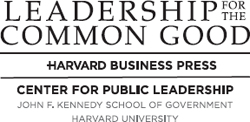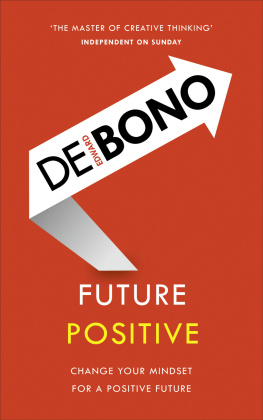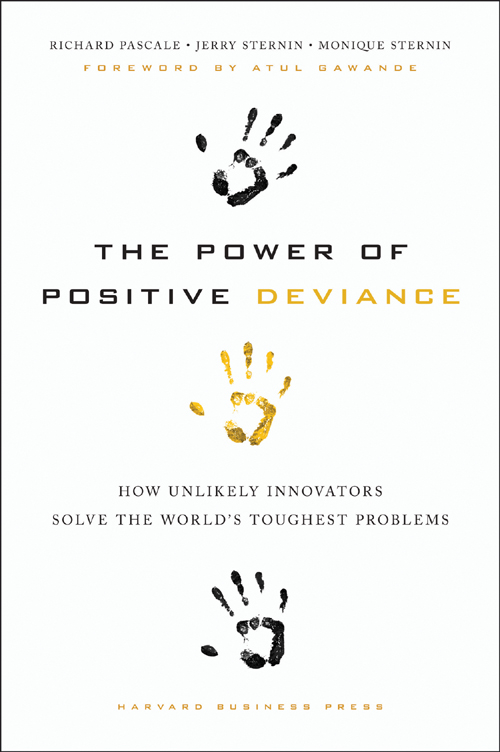Copyright 2010 Richard Pascale, Jerry Sternin, and Monique Sternin
All rights reserved
No part of this publication may be reproduced, stored in, or introduced into a retrieval system, or transmitted, in any form or by any means (electronic, mechanical, photocopying, recording, or otherwise), without the prior permission of the publisher. Requests for permission should be directed to permissions, or mailed to Permissions, Harvard Business School Publishing, 60 Harvard Way, Boston, Massachusetts 02163.
First eBook Edition: June 2010
ISBN: 978-1-4221-1066-9
The paper used in this publication meets the requirements of the American National Standard for Permanence of Paper for Publications and Documents in Libraries and Archives Z39.48-1992.

The Leadership for the Common Good series represents a partnership between Harvard Business School Press and the Center for Public Leadership at Harvard Universitys Kennedy School. Books in the series aim to provoke conversations about the role of leaders in business, government, and society, to enrich leadership theory and enhance leadership practice, and to set the agenda for defining effective leadership in the future.
OTHER BOOKS IN THE SERIES
Changing Minds
by Howard Gardner
Predictable Surprises
by Max H. Bazerman and
Michael D. Watkins
Bad Leadership
by Barbara Kellerman
Many Unhappy Returns
by Charles O. Rossotti
Leading Through Conflict
by Mark Gerzon
Senior Leadership Teams
by Ruth Wageman,
Debra A. Nunes,
James A. Burruss, and
J. Richard Hackman
Five Minds for the Future
by Howard Gardner
The Leaders We Need
by Michael Maccoby
Through the Labyrinth
by Alice H. Eagly and
Linda L. Carli
The Power of Unreasonable People
by John Elkington and
Pamela Hartigan
Followership
by Barbara Kellerman
Immunity to Change
by Robert Kegan and
Lisa Laskow Lahey
Crossing the Divide
edited by Todd L. Pittinsky
For Jerry
19382008
Positive Deviance and Health Care
Jerry Sternin was a professor of nutrition at Tufts University who, with his wife, Monique, had spent much of his career trying to reduce hunger and starvation in the world. For a while, he was the director of a Save the Children program to reduce malnutrition in poor Vietnamese villages. The usual method was to bring in outside experts to analyze the situation and then to bring in food and implement agricultural techniques from elsewhere.
The program, however, had itself become starvedof money. It couldnt afford the usual approach. The Sternins had to find different solutions with the resources at hand.
So this is what they decided to do. They went to villages in trouble and got the villagers to help them identify who among them had the best-nourished childrenwho among them had demonstrated what Jerry Sternin termed a positive deviance from the norm. The villagers then visited those mothers at home to see exactly what they were doing.
Just that was revolutionary. The villagers discovered that there were well-nourished children among them, despite the poverty, and that those childrens mothers were breaking with the locally accepted wisdom in all sorts of waysfeeding their children even when they had diarrhea; giving them several small feedings each day rather than one or two big ones; adding sweet-potato greens to the childrens rice even though they were considered to be a low-class food. These ideas spread and took hold. The program measured the results and posted them in the villages for all to see. In two years, malnutrition dropped 65 to 85 percent in every village the Sternins had visited. Their program proved in fact more effective than those of the outside experts.
_______________
I tell you this story because we are now that village.
More than that, though, we in medicine have partly contributed to these troubles. Our countrys health care is by far the most expensive in the world. It now consumes more than one of every six dollars we earn. The financial burden has damaged the global competitiveness of American businesses and bankrupted millions of families, even those with insurance. Its also devouring our government at every levelsqueezing out investments in education, infrastructure, energy development, our future.
Like the malnourished villagers, we are in trouble. As President Obama has said, The greatest threat to Americas fiscal health is not Social Security, though thats a significant challenge. Its not the investments that weve made to rescue our economy during this crisis. By a wide margin, the biggest threat to our nations balance sheet is the skyrocketing cost of health care. Its not even close. The public doesnt know what to do about it. The government doesnt know. The insurance companies dont know. There are health care experts who, during the course of the debate, have explained that a quarter of our higher costs are from having higherinsurance administration costs than other countries and higher physician and nurse pay, too. The vast majority of extra spending, however, is for the tests, procedures, specialist visits, and treatments we order for our patients. More than anything, the evidence shows, we simply do more expensive stuff for patients than any other country in the world.
So the country is now coming to us who do this work in medicine. And they are asking us, How do they get these costs under control? What can they do to change things for the better?
Health care is not practiced the same way across the country. Annual Medicare spending varies by more than double, for instancefrom less than $6,000 per person in some cities to more than $12,000 per person in others. I visited a place recently where Medicare spends more on health care than the average person earns.
You would expect some variation based on labor and living costs and the health of the population. But as you look between cities of similar circumstancesbetween places like McAllen and El Paso, Texas, just a few hundred miles apartyou will still find up to two-fold cost differences. A recent study of New York and Los Angeles hospitals found that even within cities, Medicares costs for patients of identical life expectancy differ by as much as double, depending on which hospital and physicians they use.
Yet studies find that in high-cost placeswhere doctors order more frequent tests and procedures, more specialist visits, and more hospital admissions than the averagethe patients do no better, whether measured in terms of survival, ability to function, or satisfaction with care. If anything, they seem to do worse.
Nothing in medicine is without risks, it turns out. Complications can arise from hospital stays, drugs, procedures, and tests, and when they are of marginal value, the harm can outweigh the benefit. To make matters worse, high-cost communities appear to do the low-cost, low-profit activities andserviceslike providing preventive-care measures, hospice for the dying, and ready access to a primary-care doctorless consistently for their patients. The patients get more stuff, but not necessarily more of what they need.
Fixing this problem can feel dishearteningly complex. Across the country, we have to change skewed incentives that reward quantity over quality and reward narrowly specialized individuals instead of teams that make sure nothing falls between the cracks for patients and that resources are not misused. But how do we do it?











